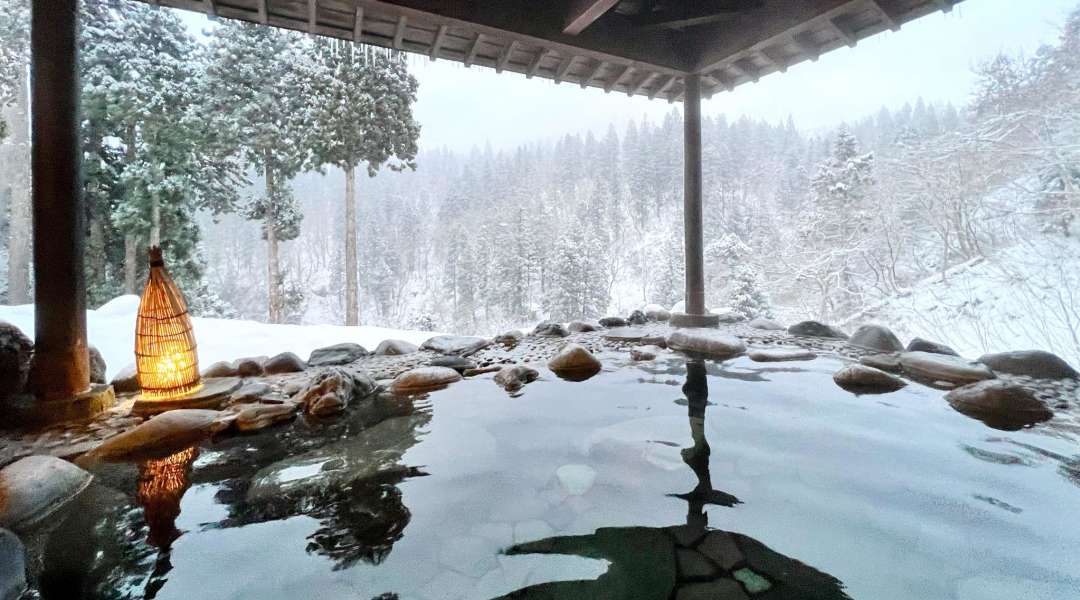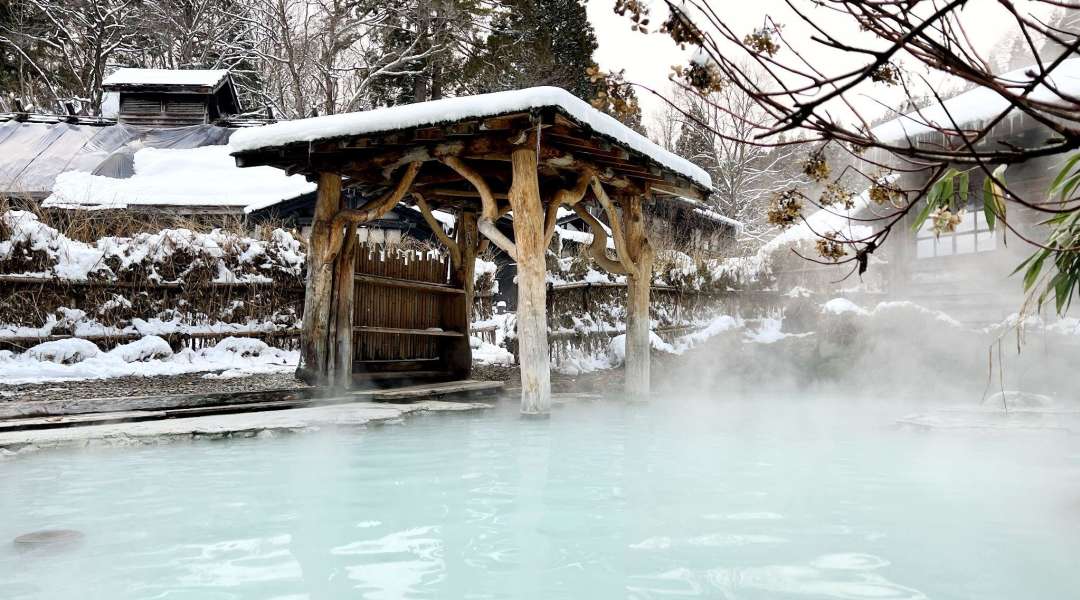
Lia is an Aussie based in Tokyo with a passion for exploring the lesser known, and learning people’s life stories. She loves to seek out ryokan traditional accommodation with private onsen hot spring baths, discover hidden sushi omakase gems or curl up in her Totoro bed with a good book. If not travelling in Japan or abroad, her days are spent in her studio, Tokyo Kaleidoscope, reconstructing vintage Japanese silk kimonos into bespoke pieces for herself and others.
A lover of onsen staycations within Japan, she has spent numerous winters enjoying hot springs around the country. We asked her to share her favourite onsen ryokan experiences in the northern Tohoku region.
5 TOHOKU WINTER ONSENS TO RELAX IN

Living in Japan, one is fortunate to experience its iconic elements like seeing Mt. Fuji through the window as the bullet train speeds towards your next adventure, eating delicious sushi in a tiny restaurant tucked away in one of the side streets, sipping local sake in a hidden bar, walking amidst the cherry blossoms blooming in the sun or snowboarding down a mountain covered in the softest, powdery snow.
However one of my favourite aspects of living in Japan, is soaking in a deliciously hot outdoor onsen surrounded by nature, away from the crazy hustle and bustle of Tokyo life, and the Tohoku region has some of the best remote onsen towns to relax in.
TSURU NO YU - Nyuto Onsen, Akita Prefecture

Akita Prefecture lies on the north western side of Honshu. The name Akita means “autumn rice paddy” and the area is famous for its rice farming, sake breweries and of course the popular Akita dog. The region is also renowned for the beautiful women of the region “Akita bijin,’ (秋田美人, 'beauties of Akita’).
In present day, the term “Akita bijin” has been used to promote many aspects of the Akita culture, whether it's cosmetics, food, travel, and of course the region's healing and beautifying hot spring waters.
Nestled at the foot of Mt. Nyuto amidst a beech forest, lies the oldest onsen ryokan Tsuru no Yu in Nyuto Onsen town. Over 300 years old, Tsuru no Yu is a throwback to an era gone by when samurai and lords would visit this magical onsen for its healing properties. The spring's name comes from when a local hunter saw the majestic white crane healing its wounds in the spring, and thus it was called “Tsuru no Yu (crane’s hot spring)”.
The mixed-gender onsen, with its milky turquoise blue waters, is perhaps its most iconic and popular feature. Soaking in its waters as snow flurries gently drift down upon you is truly a magical time. As the waters are milky blue, you cannot see other people's body parts (and the female’s entrance is sheltered). However, if you’re still not comfortable with mixed nudity, ladies have the option of their own outdoor onsen with the same waters. Similar in size, it’s framed with hinoki wood instead of rocks.

AONI ONSEN - Kuroishi, Aomori Prefecture

Resting at the top of Japan’s main island Honshu is Aomori Prefecture, one of my favourite prefectures in Japan to explore (almost contemplated buying an akiya empty house to renovate). Lush greenery, waterfalls and a large glimmering lake await you in Oirase Gorge in Towada-area, Hirosaki City has one of the prettiest cherry blossom spots to see in spring, and Aomori City hosts the stunning Nebuta Festival in the summer. Travel deep into the mountains of Kuroishi to relax in my favourite rustic mountain onsen.
Lit only by traditional oil lamps, Aoni Onsen takes you back from the modern life that we’ve become accustomed too, for generally there is no electricity in the buildings (I think maybe now there’s some for the kitchen fridge), the property is so deep in the mountains that no reception comes through for your phones, so you can properly disconnect and just appreciate existence.
As common with these remote onsen ryokans, there is a main mixed open-air bath onsen (which is generally the prettiest bath) of a large rock rotenburo outdoor bath and round barrel overlooking the Aoni river valley, and various gender-separated options. For the popular mixed open-air bath, there is a ladies only time of 11-12pm and 5-6pm.

TSUCHIYU BETTEI SATONOYU - Tsuchiyu Onsen, Fukushima Prefecture

The third largest prefecture in all of Japan (after Hokkaido and Iwate), and the closest from Tokyo, Fukushima came to international attention after the 2011 Earthquake and subsequent nuclear disaster. Nowadays the area is slowly reclaiming and revitalising itself. There’s much to experience in Fukushima, from one of the prettiest, preserved samurai towns of Aizu Wakamatsu (and a stunning castle), through a plethora of sake breweries to sip and savour, its abundance of fruit production and fruit picking activities (Fukushima is dubbed the “Kingdom of Fruits” in Japan), to stunning natural scenery and numerous onsen towns to soak in.
Tsuchiyu Onsen town is located at the heart of Mt. Azuma and its history stretches for over 1000 years. Here you can spend days strolling through this charming, quaint traditional onsen town, where various shops sell the town’s famous Kokeshi dolls or even join a Kokeshi Doll workshop. Several onsen ryokans are available to enjoy, but for those wishing for a little bit of luxury in their relaxation, book a stay at the gorgeous, boutique Tsuchiyu Bettei Satonoyu located in the Bandai Asahi National Park. With only 9 rooms available (including 1 independent cottage), the attention to detail and service are wonderful. Rooms are designed in a simplistic, modern yet traditional Japanese style by some of the finest craftsmen in Japan, all with indoor baths that have a hot spring source (two rooms have private outdoor onsen baths available). There are three onsen baths available to enjoy within the premises, all of which are private. Simply book for the time you wish to go with the staff. My favourite is Shinpeki, their outdoor rotenburo and hinoki wood bath located in the forest itself.

YUUKAEN - Hanamaki Onsen, Iwate Prefecture

Said to be the last untouched frontier of Japan by the locals, Iwate Prefecture is abundant in natural beauty, with 5% of its total land area designated as national parks. Iwate has four distinct areas, the urban capital of Morioka, Miyako City known for its picturesque coastline, the famed “City of Folklore” also known as Tono, and Hanamaki - famed for its many historical and cultural sites, a plethora of steaming onsen and various sake breweries.
Many of these sake breweries only sell within the prefecture themselves, and are acclaimed throughout the country. So if you ever visit make sure to pick up a few bottles, especially those produced by Naotaka Kawamura of Kawamura Shuzo, the self-proclaimed “sake outlaw”. His bottles are only found in a few select restaurants and shops approved by the man himself.
After sipping your way through the sake and wine breweries in Hanamaki, relax in a ryokan in Hanamaki Onsen Minami Gorge. One of the prettiest and most stunning onsen ryokans I’ve stayed in is Yuukaen. Designed by palace carpenters, the majority of the building has been made using the traditional ancient craftsmanship of tsugite (other names: kigumi and kanawatsugi) where no nails or bolts are used. It is the beautiful wood joinery often found in temples, shrines, and palaces where every detail is a perfect puzzle piece fitting together perfectly. The ceilings are constructed in the goubuchi style which is formed via a regular division pattern by assembling the rims vertically, horizontally, and squarely. There are several open-air and indoor onsen to enjoy, and in fact Yuukaen has some of the largest ones to relax in within Iwate Prefecture.

TAKIMIKAN - Ginzan Onsen, Yamagata

Until the Meiji Restoration known as part of the Dewa province, Yamagata Prefecture is surrounded by mountains on its borders, the most famous being “Dewa Sanzan (The Three Mountains of Dewa)”: the sacred trio of Mount Haguro, Mount Hassan and Mount Yudono. It's a popular pilgrimage site and a place where you may see the Japanese mountain monks “Yamabushi” paying reverence to nature. Out of the three mountains, Mount Haguro is the only one accessible year round and is the location of the “Gojunoto”, the famous five story pagoda, a national treasure.
The prefecture is also renowned for being home to Ginzan Onsen, with one of Japan's prettiest winter onsen town sceneries. Built on the site of a former silver mine, this tiny onsen town (which can easily be walked around in about 15 minutes or less if you’re not taking photos) is extremely popular for its old world atmosphere, especially in winter when the snow covers its traditional ryokan buildings creating a nostalgic winterscape.
Various small onsen ryokans line the small streets bordering the Ginzan River, with many booked out a year in advance during certain seasons. Its most popular and largest ryokan is Ginzanso at one end of the town, however, nestled at the top of the hills on the other side of Ginzan is Takimikan “The Soba & Waterfall Inn”. Overlooking Shirogane waterfalls, it's a charming boutique ryokan built in the Taisho Roman style with only 14 rooms. Beautiful snowy mountain views greet you every winter morning from your window, and its panoramic open-air rotenburo is magnificent to soak in and appreciate the stunning natural landscape.

Whether you want to find that picture-perfect onsen town or relax and enjoy a digital detox, you can find it all and more in the northern Tohoku region with its stunning natural views and rejuvenating onsen hot springs. Long soaks after thrilling days filleed with winter adventures await!
Follow Lia as she explores more areas of Japan intimately, over on her IG @ryokanwanderings or have a read of her blog: Ryokan Wanderings for even more stories and adventures.

















































